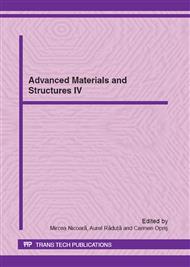[1]
L.J. Gibson, M.F. Ashby, Cellular solids, Structure and properties, Second edition, Published by the Press Syndicate of the University of Cambridge, 1997.
Google Scholar
[2]
L. Marsavina, T Sadowski, D.M. Constantinescu, R. Negru, Polyurethane Foams Behaviour. Experiments versus Modeling, Key Eng. Mat., 399, (2008) 123-130.
DOI: 10.4028/www.scientific.net/kem.399.123
Google Scholar
[3]
V. P. W. Shim, K. Y Yap, Modeling impact deformation of foam-plate sandwich systems. Int. J. of Imp. Eng., Vol. 19, No. 7 (1997), 615-636.
DOI: 10.1016/s0734-743x(96)00049-8
Google Scholar
[4]
E. Linul, L. Marsavina, Experimental determination of compressive properties for rigid polyurethane foams, Buletinul Universitatii Petrol-Gaze din Ploiesti. Seria Tehnica, Vol. LXIII, No.1 ( 2011), 199-204.
Google Scholar
[5]
L. Marsavina, Fracture Mechanics of Cellular Solids, in H. Altenbach. A. Ochsner (Eds.), Cellular and Porous Materials in Structures and Processes, Springer, Wien, 2010.pp.1-33.
Google Scholar
[6]
D. Zenkert, PVC sandwich core materials: fracture behaviour under mode II and mixed mode loading, Mat. Sci. and Eng. 108 (1989) 233–240.
DOI: 10.1016/0921-5093(89)90425-5
Google Scholar
[7]
D. Zenkert, J. Bäcklund, PVC sandwich core materials: mode I fracture toughness. Comp. ScI. and Tech. 34 (1989) 225–242.
DOI: 10.1016/0266-3538(89)90030-4
Google Scholar
[8]
O.B. Olurin, N.A. Fleck, M.F. Ashby, Tensile and Compressive Failure of Notched Cellular Foams, Adv. Eng. Mat. 3 (1–2)( 2001) 55–58.
DOI: 10.1002/1527-2648(200101)3:1/2<55::aid-adem55>3.0.co;2-2
Google Scholar
[9]
N.A. Fleck, O.B. Olurin, C. Chen, M.F. Ashby, The effect of hole size upon the strength of metallic and polymeric foams, J. of the Mech. and Phys. of Sol. 49 (2001) 2015–2030.
DOI: 10.1016/s0022-5096(01)00033-3
Google Scholar
[10]
Z.P. Bažant, J. Planas, Fracture and Size Effect in Concrete and Other Quasibrittle Materials. CRC Press, Boca Raton and London (Sections 9.2 and 9.3), (1998).
DOI: 10.1201/9780203756799
Google Scholar
[11]
Z.P. Bažant, Scaling of Structural Strength, Hermes-Penton, London, 2002.
Google Scholar
[12]
P. Zdenek, Z.P. Bažant, Z. Yong, Z. Goangseup, M.D. Isaac, Size effect and asymptotic matching analysis of fracture of closed-cell polymeric foam, Int. J. of Sol. and Struc. 40 (2003) 7197–7217.
DOI: 10.1016/s0020-7683(03)00362-7
Google Scholar
[13]
Z.P. Bažant, Size effect in blunt fracture: Concrete, rock, metal, J. of Eng. Mech. ASCE 110 (1984) 518–535.
DOI: 10.1061/(asce)0733-9399(1984)110:4(518)
Google Scholar
[14]
Z.P. Bažant, M.T. Kazemi, Determination of fracture energy, process zone length and brittleness number from size effect, with application to rock and concrete, Int. J. of Fract. 44 (1990) 111–131.
DOI: 10.1007/bf00047063
Google Scholar
[15]
ASTM D 5045-99 Standard Test Methods for Plane-Strain Fracture Toughness and Strain Energy Release Rate of Plastic Materials.
DOI: 10.1520/d5045-14r22
Google Scholar


